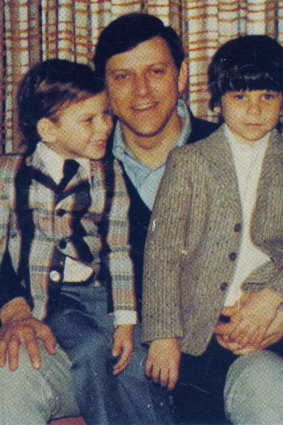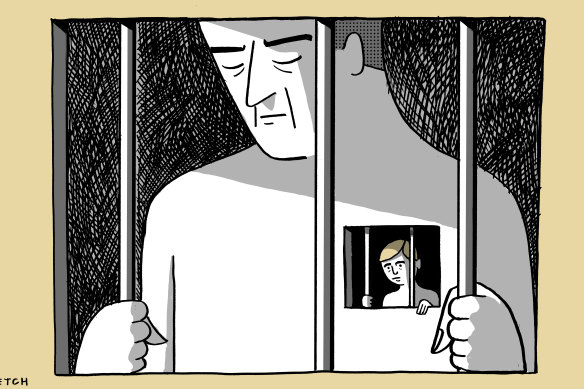This was published 9 months ago
Opinion
Were the Menendez brothers monsters or monstered? Young boys need the answer
Julia Baird
Journalist, broadcaster, historian and authorOh, to have been present during the jury deliberations at the first trial of the Menendez brothers in California in 1994. Erik and Lyle Menendez – handsome, rich, reserved and tormented – had told the court they murdered their parents in their home because they were afraid of their father, Jose, who had sexually and emotionally abused them for years. Lyle claimed his father’s abuse began when he was just six, before Jose moved on to rape his younger brother, Erik, when he, too, was about six.
Lyle, at 21, had just discovered that 18-year-old Erik was still being abused, and had confronted his father, who became enraged.

Accused of murdering their parents, Lyle and Erik Menendez.Credit: AP
This case has now re-emerged, currently roiling on TikTok and being revisited in both a fictionalised account (Monsters: The Lyle and Erik Menendez Story) and a documentary (The Menendez Brothers) on Netflix. It scandalised America in the 1990s, especially given the contrast of the gruesome murder with the outward appearance of an affluent family in Beverley Hills. Jose was a successful media executive. The boys’ mother, Kitty, had been a beauty queen.
While recognising Jose was vile, Pamela Bozanich, the lawyer for the prosecution, argued – and still argues – the boys’ claims were pure fabrication. Several friends and family members corroborated the brothers’ stories, but direct evidence was difficult to obtain.
Bozanich had plenty of material to work with. The spending spree the brothers went on after the murders – a Porsche Carrera, a restaurant, three Rolexes – made them look callous, motivated by greed. It was reported that Jose had just threatened to cut them out of his will. Were they seeking to cut him out instead? After all, Erik had written a screenplay with a friend about a teenager killing his parents to inherit money – called “Friends”.
But, seeing the raw emotion in the footage of the brothers when testifying about what their father did to them is disturbing: the pain on Erik’s face when he watched Lyle; the shame on Lyle’s as he apologised to Erik for acting out some of his father’s actions on his brother, repeating the abuse. Hearing this, Erik bites his knuckles, stifling sobs.
After weeks of deliberation, both of their juries were hung, and the cases were mistrials. (They were tried together but had separate juries because some evidence was admitted only against one brother.) The decision to be made was not about the facts of the murder but the length of the sentence, whether it was first-degree murder or voluntary manslaughter.
Fascinatingly, Erik’s jury was entirely split along gender lines. The New York Times reported that this was not coincidental. Female jurors spoke about sexism and homophobia in the jury room. One 27-year-old juror, a bookstore clerk, said: “It was hostile in there. There were insults, sexual comments. They tried to outshout us.” Another, a 36-year-old secretary, said: “We were called ignorant asses and empty-headed and ‘those women’.” The jury rooms were “unhappy” and emotional.
Put simply, the women mostly believed the brothers had been raped and the men didn’t. Juror Hazel Thornton, a 36-year-old engineer, told the NYT she had tried to turn the talks toward issues like burden of proof or the concept of malice, but the male jurors were more interested in whether Erik Menendez was homosexual. Her belief was “the men just have too hard a time considering the fact that grown teenage boys could be abused and not just leave”.

Erik, left, and Lyle with their father, Jose Menendez.
While researching the case, Robert Rand, author of The Menendez Murders, found the jury had asked to re-read “all testimony or allusions to Erik’s homosexuality”. In 1996, Erik told broadcast journalist Barbara Walters he was not gay, adding: “The prosecutor brought that up because I was sexually molested. He felt in his own thinking that I was sodomised by my father, I must have enjoyed it.”
At the brothers’ second trial in 1995, the judge did not allow the admission of evidence about abuse. Both men were convicted of first-degree murder and jailed for life without parole.
In 1992, the year before the first trial began, a paper was presented at the annual meeting of the American Society of Criminology finding a strong connection between parricide and “covert sexual abuse”. In 1994, trial attorney Paul Mones argued in the journal Trial that “parricide is usually the act of a severely abused child, and this should be taken into account when determining the criminal liability of the child”. Mones said that, just as domestic violence was sometimes taken into account if a woman killed a partner, sexual abuse should be factored in to parricide – “battered child syndrome”. His findings were chilling: “Sons commit about 90 per cent of all parricides. Most are 17- to 18-year-old white middle to upper-class youths with no history of antisocial or violent behaviour. Their facades, however, hide lives of chaos and persecution … The parents who perpetrate the abuse are typically successful …”
(We should note that, across America, it was legal at the time, and still is in 30 states, to use the “gay panic” defence as a mitigating factor, meaning the mere suggestion a man might be sexually interested in you can explain, if not excuse, acts of violence against that man. But not, perhaps, if that man is your father.)
Little wonder there have been calls to reconsider the case. The brothers filed a petition last year which included new evidence: the claim by pop star Roy Rosselló that he was drugged and raped by Jose when he was a teenager, and a letter written by a teenage Erik to a cousin speaking of his fears of his father’s abuse just eight months before the murder.

Illustration: Simon LetchCredit:
In recent days, about 20 family members have called for their release. Kitty’s sister, Joan Andersen VanderMolen, said: “It became clear that their actions – while tragic – were the desperate response of two boys trying to survive the unspeakable cruel[ty] of their father. The whole world was not ready to hear that boys could be raped. Today we know better.” In fact, Bozanich argued in court that the brothers could not have been raped “because men lack the necessary equipment to actually be raped”.
All of this has led to a necessary examination of the bias of the justice system against male sexual assault victims. Men who are told to “man up”, to fight, to leave, to pretend they are OK, not shattered and traumatised. Men who rarely report. Erik told Barbara Walters he and Lyle fought because Lyle felt that to speak about the father’s sexual torture publicly would be killing their father twice. When Lyle finally did speak, “there was a great outpouring but there was also people laughing at him, and it was strange”.
Now the justice system has a chance to examine whether bias against men who survive rape prevents them getting a fair hearing. Trauma can do terrible things to kids, curdle hearts, usher in darkness. We’re all guessing at what happened, really, in their minds and in those shadowed rooms. The facts of the murders remain.
And yet imagine the harm done to all those boys watching that case, watching the brothers become the subject of late-night TV jokes, watching them being mocked, ridiculed and disbelieved, and internalising the shame, remaining silent.
Julia Baird is a journalist, author and regular columnist. Her latest book is Bright Shining: how grace changes everything.